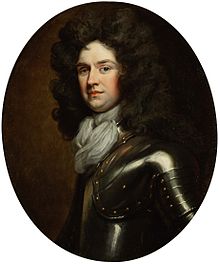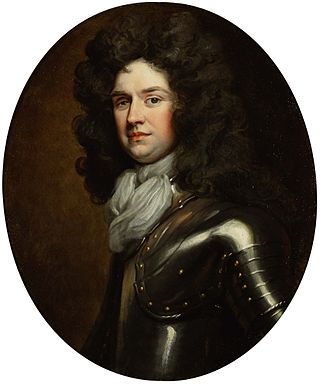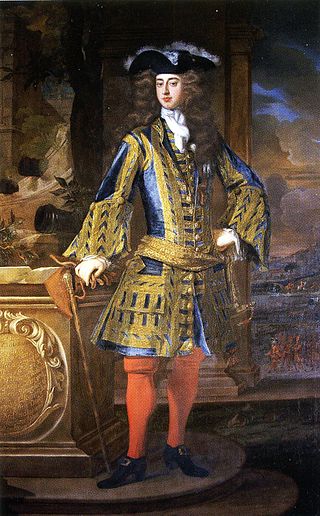David Colyear, 1st Earl of Portmore
Last updatedThe Earl of Portmore | |
|---|---|
 The Earl of Portmore | |
| Governor of Gibraltar | |
| In office 1713–1720 | |
| Preceded by | Thomas Stanwix |
| Succeeded by | Richard Kane |
| Personal details | |
| Born | 1656 |
| Died | 2 January 1730 (aged 73–74) Weybridge,Surrey |
| Spouse | |
| Children | David Colyear, Viscount Milsington Charles Colyear, 2nd Earl of Portmore |
| Military service | |
| Allegiance | |
| Branch/service | British Army |
| Rank | General |
| Battles/wars | Nine Years' War War of the Spanish Succession |
General David Colyear, 1st Earl of Portmore, KT , PC (c. 1656 – 2 January 1730) was a Scottish general and Governor of Gibraltar.
Contents
Early life
He was the elder son of Sir Alexander Colyear, 1st Baronet, of the family of Strowan, Perthshire, who settled in Holland, where he acquired a considerable property, and preferred the name of Colyear. [1]
Career
Colyear was commissioned into the Army of William of Orange in 1674, becoming Lieutenant-General of the Scots Brigade, the three Scottish regiments which had been fighting in the service of the Netherlands for many decades.
He led the troops ashore when William landed at Torbay on 5 November 1688 and then served in most of William's Irish campaigns, being made Governor of Limerick in 1691. For his service in Ireland he was created Lord Portmore on 1 June 1699. In 1702, he obtained the rank of major-general, and on 27 February 1703 received the command of the Queen's Royal Regiment of Foot, later the 2nd Foot. On 13 April 1703, he was raised to the dignities of Earl of Portmore, Viscount of Milsington, and Lord Colyear. [1]
He took part in the War of Spanish Succession and participated in the Battle of Cádiz in 1702 and the Battle of Vigo Bay later that year. [1] In 1710, he was appointed commander-in-chief of the forces in Scotland, and in January 1711 was raised to the rank of general. In 1712, he served under the Duke of Ormonde in Flanders, and the same year he was named a member of the privy council and made a Knight of the Thistle. [1]
In August 1713, he was constituted Governor of Gibraltar (gazetted November 1714 [2] ), and in October of the same year he was chosen one of the sixteen representative peers of Scotland. When Gibraltar was besieged by the Spaniards in 1727, he embarked for that place to assume command, but on the approach of Admiral Wager with eleven ships the siege was raised. [1]
Personal life

He married Catherine Sedley, Countess of Dorchester, daughter of the former Lady Catherine Savage (a daughter of John Savage, 2nd Earl Rivers) and poet Sir Charles Sedley, 5th Baronet, of Southfleet, Kent. [1] Catherine, a former mistress of James II, had been created Countess of Dorchester for life in 1686. Together, they were the parents of two sons:
- David Colyear, Viscount Milsington (1698–1728/9), who married Bridget Noel, only daughter of Hon. John Noel (second son of Baptist Noel, 3rd Viscount Campden) and Hon. Elizabeth Ingram (widow of Edward Ingram, 2nd Viscount Irvine, sister of Bennet Sherard, 1st Earl of Harborough, and eldest daughter of Bennet Sherard, 2nd Baron Sherard), in 1724. [1]
- Charles Colyear, 2nd Earl of Portmore (1700–1785), who married Juliana Osborne, Duchess of Leeds, widow of Peregrine Osborne, 3rd Duke of Leeds, the daughter and heiress of Roger Hele, of Halewell. [1]
He died 2 January 1730 and was succeeded in the earldom by his second won, Charles. [1]
Arms
|
Related Research Articles

Lionel Cranfield Sackville, 1st Duke of Dorset was an English peer and politician who served as Lord President of the Council from 1745 to 1751. He also twice served as Lord Lieutenant of Ireland from 1730 to 1737 and again from 1750 to 1755.

Earl of Portmore was a title in the Peerage of Scotland. It was created in 1703 for the Scottish military commander David Colyear, 1st Lord Portmore. He had already been created Lord Portmore in 1699 and was made Lord Colyear and Viscount of Milsington at the same time as he was granted the earldom, also in the Peerage of Scotland. He was the son of Alexander Colyear, who had been created a Baronet, of Holland, in the Baronetage of England on 20 February 1677. Lord Portmore married Catherine Sedley, Countess of Dorchester, a former mistress of James II. He was succeeded by his only surviving son, the second Earl. He represented Wycombe and Andover in Parliament. His grandson, the fourth Earl, sat as Member of Parliament for Boston. The fourth Earl died without surviving male issue in 1835 when the titles became extinct.

Catherine Sedley,suo jureCountess of Dorchester and Countess of Portmore, daughter of Sir Charles Sedley, 5th Bt, was the mistress of King James II of England both before and after he came to the throne. Catherine was noted not for beauty but for her celebrated wittiness and sharp tongue.

Lord Sherard, Baron of Leitrim, was a title in the Peerage of Ireland in 1627. The third holder of the barony would also be named Baron Harborough (1714), Viscount Sherard (1718), and Earl of Harborough (1719), with the viscountcy ending with the death of its original holder in 1732, but the other titles persisting in the family until 1859. The Sherard barony became dormant in 1931 with the death of the last known male-line family member.

William Charles Colyear, 3rd Earl of Portmore (1745–1823) was a Scottish peer, styled Viscount Milsington until 1785.

John Manners, 2nd Duke of Rutland KG, styled Lord Roos from 1679 to 1703 and Marquess of Granby from 1703 to 1711, was a British Whig politician who sat in the English and British House of Commons from 1701 until 1711, when he succeeded to the peerage as Duke of Rutland.

Earl of Dorchester, in the County of Dorset, was a title in the Peerage of Great Britain. It was created in 1792 for Joseph Damer, 1st Baron Milton. He was a politician but is best remembered for the reshaping of Milton Abbey and the creation of the village of Milton Abbas in Dorset. Damer had already been created Baron Milton, of Shronehill in the County of Tipperary, in the Peerage of Ireland, in 1753 and Baron Milton, of Milton Abbey in the County of Dorset, in the Peerage of Great Britain, in 1762. In 1792 he was made Viscount Milton, of Milton Abbey in the County of Dorset, at the same time he was given the earldom. He was succeeded by his elder son. The second earl was a politician and notably served as Chief Secretary for Ireland between 1794 and 1795. He was unmarried and the titles became extinct on his death in 1808.

Charles Colyear, 2nd Earl of Portmore, KT, known as Lord Milsington to 1730, of Portmore House, Weybridge, Surrey, was a British Whig politician who sat in the House of Commons between 1726 and 1730, when he succeeded to the peerage as Earl of Portmore. He subsequently became a Scottish representative peer in the House of Lords. He was a racehorse owner and was known as Beau Colyear for his conspicuous dress.

Lord Sherard Manners was an English nobleman and Member of Parliament.
Events from the year 1703 in the Kingdom of Scotland.
Bennet Sherard, 1st Earl of Harborough was a British peer and Member of Parliament.

Philip Sherard, 2nd Earl of Harborough, of Whissendine, Rutland, was a British landowner and Whig politician who sat in the House of Commons from 1708 to 1710 and later succeeded to the peerage as Earl of Harborough.

Baptist Noel, 3rd Viscount Campden was an English politician. He was Lord Lieutenant of Rutland, Custos Rotulorum of Rutland and the Member of Parliament for Rutland.

The Earldom of Harborough was a title in the Peerage of Great Britain created in 1719 for Bennet Sherard, who had previously been made Baron Harborough (1714) and Viscount Sherard, with the viscountcy ending with the death of its original holder in 1732, but the other titles, created with special remainders to the grantee's cousin, persisted until 1859.
Henry Ingram (1640–1666) was the first to hold the title Lord Ingram, and Viscount Irvine, in the Peerage of Scotland, which in English sources is usually written Viscount Irwin. The Viscountcy existed in four generations of his family before becoming extinct: the seat was at Temple Newsam near Leeds, in Yorkshire.
John Noel, of North Luffenham, Rutland was a British politician who sat in the House of Commons between 1711 and 1718.

Elizabeth Sackville, Duchess of Dorset, formerly Elizabeth Colyear, was a British court official and noble, the wife of Lionel Sackville, 1st Duke of Dorset.
Juliana Colyear, Countess of Portmore was an English noblewoman. She was the third wife of Peregrine Osborne, 3rd Duke of Leeds, and later the wife of Charles Colyear, 2nd Earl of Portmore, and mother of the 3rd Earl.
Bennet Sherard, 2nd Baron Sherard DL was a British politician and Irish peer. An influential landowner in Leicestershire and Rutland, he was returned to Parliament by the former county from 1679 through 1695, although his Parliamentary activity was minimal. He entered Parliament as a supporter of the Exclusion Bill, and was one of the Whigs purged from county offices in 1688 over James' policy of religious tolerance. He supported James' overthrow in the Glorious Revolution, and was appointed Lord Lieutenant and Custos Rotulorum of Rutland, offices he held until his death in 1700.
Sir Alexander Colyear, 1st Baronet was a Scottish gentleman who lived most of his life in the Netherlands. He was created a baronet in the Baronetage of England in 1677 and is the ancestor of the Earls of Portmore in the peerage of Scotland.
References
- 1 2 3 4 5 6 7 8 9 Henderson 1887.
- ↑ "No. 5274". The London Gazette . 2 November 1714. p. 4.
- Attribution
![]() This article incorporates text from a publication now in the public domain : Henderson, Thomas Finlayson (1887). "Colyear, David". In Stephen, Leslie (ed.). Dictionary of National Biography . Vol. 11. London: Smith, Elder & Co. pp. 424–425.
This article incorporates text from a publication now in the public domain : Henderson, Thomas Finlayson (1887). "Colyear, David". In Stephen, Leslie (ed.). Dictionary of National Biography . Vol. 11. London: Smith, Elder & Co. pp. 424–425.
External links
- Henderson, T. F. (2004). "David Colyear". Oxford Dictionary of National Biography . Oxford Dictionary of National Biography (online ed.). Oxford University Press. doi:10.1093/ref:odnb/6015.(Subscription or UK public library membership required.)
- The Queen's Royal Surrey Regimental Association
- Leigh Rayment's Peerage Pages